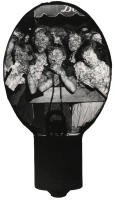
Weegee, [Opening night, Metropolitan Opera, New York], November 23, 1942 (235.1984)

PM, November 28, 1942, p. 14
Weegee Brings Back a ‘Different’ Picture of Opera’s Opening Night
Weegee, the photographer who lives next door to Police Headquarters and who specializes in covering crime, went up to the opening of the opera last Monday night and took this picture. It shows a meeting in the lobby of the Metropolitan Opera House, after the performance of Daughter of the Regiment, between one of the patrons and a bearded man who had been standing there alone during the last act. “As they came out,” Weegee told us, “the high-hatted folks had looked at the old man in amazement; some murmured ‘What a character!’ Then this monocled one came through the door and patted him on the shoulder, asking, ‘How are you, my good fellow?'” The camera caught the man’s quick smile, but he hurried away before Weegee could find out his name. The democratic opera-goer is Dr. Bertram Cecil Eskell of the British Consulate. “I bet he must be a Lord,” said Weegee, “and even if he isn’t he surely is an ambassador of good fellowship.” Later Weegee interviewed a traffic cop outside the Met, where the limousines had been parked clear to 5th Ave., two blocks away. “This is their last splurge,” said the cop, “and they must have had to save their gas coupons for it. Some of the cars had two liveried chauffeurs – one to steer and the other to push when they run out of gas, I suppose.” (For other details of opening night at the Opera House, see page 6.)

PM, November 28, 1942, p. 6
We get a press-side view of the Met opening
One of he biggest local items this week was the opening of the opera. We’re of the century of the common man [people] ourself, but we wanted to see how the other, or Frank Crowninshield half, lives.
We stationed ourself in the 39th St. lobby through which the carriage trade passes, among the battery of press photographers facing the doors. The fashion and society writers clustered to the right of the entrance…Just before 9, the REAL, REAL personage arrived. Beekman stood in silent awe. We didn’t have to say anything. Mrs. George Washington Kavavaugh stood there, supporting her diamonds and emeralds. Of course, everybody REAL had worn a few diamonds but this was a display. And Mrs. Kavanaugh just stood there while everybody stared – beaming in simple, unashamed, childlike joy.
The completely unsophisticated pleasure of the crowd at the sight of those jewels astonished us. Up to this time, everyone had been keeping up the show of being as snooty as the next fellow, quite accomplished to this sort of thing, don’t y’know. A woman behind us murmured “disgusting,” but her heart wasn’t in it.
Mrs. Kavanaugh was accompanied by her daughter, Mrs. Leonore Warner, whose jewels were insignificant by any standard and whose news value was completely overshadowed by her mother’s…

Weegee, [Opening night, Metropolitan Opera, New York], November 23, 1942 (7253.1993)
For the third consecutive year Weegee’s strategy: “I wanted to get something different than the usual Society celebrities” was successful. For the second consecutive year Mrs. George Washington Kavanaugh was in PM‘s coverage of the Metropolitan Opera’s opening night. Many opera goers wore black and many wore uniforms for the first wartime opera opening since 1917. (The “two chauffeurs” bit might be more of a joke than factual.) Perhaps Mrs. Kavanaugh was (and will be) an obvious and ostentatious target for satire. The opening on Monday, November 23, 1942, sets the scene for the next opening in 1943.
The opera was Gaetano Donizetti, Jules-Henri Vernoy de Saint-Georges, and Jean-François Bayard’s La fille du régiment (1839). Lily Pons was Marie. The conductor was Frank St. Leger. Apparently the opera began and ended with the orchestra performing “The Star-Spangled Banner.” At the end of the opera, after Ms. Pons sang the “Marseillaise,” an American flag was brought onstage and “the orchestra began ‘The Star-Spangled Banner.’ The leading singers and chorus on the stage, supported by the more than 3,000 men and women in the capacity audience, sang it with rousing feeling.” (The New York Times, November 24, 1942.)
Because of the war the bright white lights of the marquees were red and blue to meet the rules of the dim-out. There were large signs that read “This Corridor Is a Shelter Area.” The Times also reported that “some things never change at a Metropolitan Opera opening: The photographers madly plied their trade in the Thirty-ninth Street foyer, where the famous patrons arrived. Flashlights went off, camera men tried to catch last shots inside the corridor, and there was at least one violent squabble between a photographer on the one hand and an opera official and a fireman on the other.” (The New York Times, November 24, 1942.)
Dr. Bertram Cecil Eskell graduated from Oxford and the Royal College of Surgeons of England. At his wedding to Ludmilla Aissa Alihan at a Russian Orthodox church on East 121st St. the actor Raymond Massey was the best man. The Times reported that two mink coats valued at $700 ($10,537 today) and $1,650 ($24,836 today) were stolen from two New Jersey women during the intermission after the first act.
The “Lee” in the “To Lee” inscription is the great New York photographer, friend of Weegee, and ICP librarian Lee Sievan (1907-1990).
Will Weegee return to the Metropolitan Opera for the the opening night festivities in 1943?
If so, will he “get something different than the usual Society celebrities”?
Of course!
Stay tuned for “The Critic at 75.”

